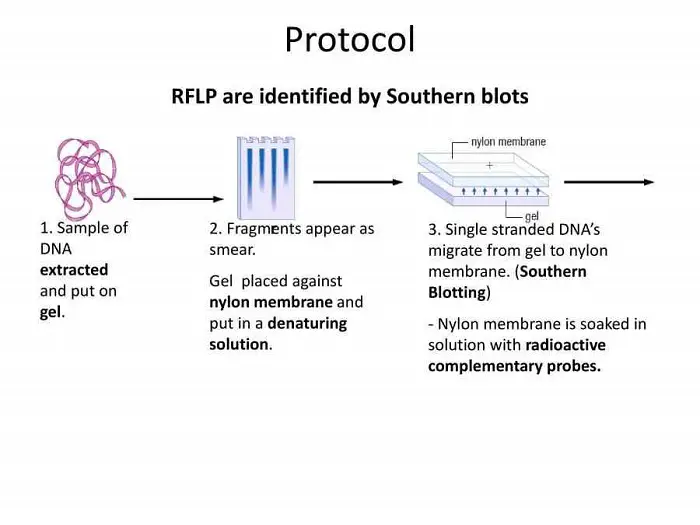RFLP stands for Restriction Fragment Length Polymorphism. It is a molecular biology technique that exploits variations in DNA sequences to produce a unique pattern of fragments when DNA is digested with restriction enzymes. These variations in fragment lengths are due to differences in the DNA sequence, such as the presence or absence of restriction sites or the DNA length between restriction sites.
Types of Restriction Fragment Length Polymorphism
- Genomic RFLP: In this type of RFLP, DNA from the entire genome is digested with restriction enzymes to generate a pattern of fragments. These fragments can then be separated using gel electrophoresis to analyze the DNA sequence variation.
- Mitochondrial RFLP: Mitochondrial DNA (mtDNA) RFLP analysis targets the mitochondrial genome specifically. It’s instrumental in evolutionary studies and population genetics due to the maternal inheritance pattern of mtDNA.
Uses and Applications of RFLP
- Genetic Mapping: RFLP analysis has been widely used in genetic mapping to identify the chromosomal location of genes or genetic markers. By analyzing the inheritance pattern of RFLP markers in families, researchers can create genetic linkage maps showing genes’ relative positions on chromosomes.
- Forensic Identification: RFLP analysis was one of the earliest DNA-based methods used in forensic science for individual identification. By comparing RFLP patterns between a crime scene sample and a suspect’s DNA, forensic scientists can determine whether the suspect’s DNA matches the DNA found at the crime scene.
- Population Genetics: RFLP analysis is valuable in population genetics studies for assessing genetic variation within and between populations. Researchers can infer evolutionary relationships, migration patterns, and genetic diversity by analyzing RFLP patterns in different populations.
- Disease Association Studies: RFLP analysis has been used in genetic studies to investigate associations between genetic variants and diseases. By comparing RFLP patterns between individuals with a particular disease and healthy controls, researchers can identify genetic markers linked to disease susceptibility.
- Evolutionary Studies: RFLP analysis of mitochondrial DNA has been used to study evolutionary relationships and population genetics across various species. It helps researchers understand populations’ and species’ genetic diversity and evolutionary history.
Advantages and Limitations of Restriction Fragment Length Polymorphism
- Advantages: RFLP analysis can detect genetic variations, including single nucleotide polymorphisms (SNPs), insertions, deletions, and copy number variations. It’s a robust and versatile technique with numerous applications in genetics research.
- Limitations: RFLP analysis requires relatively large amounts of high-quality DNA, which can be time-consuming and labor-intensive. Moreover, it’s less sensitive and has a higher throughput than modern DNA sequencing techniques. As a result, RFLP has largely been replaced by more efficient methods for many applications, although it still has niche uses in certain areas of research and forensic science.
